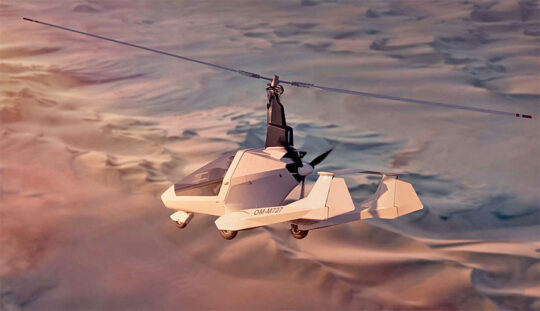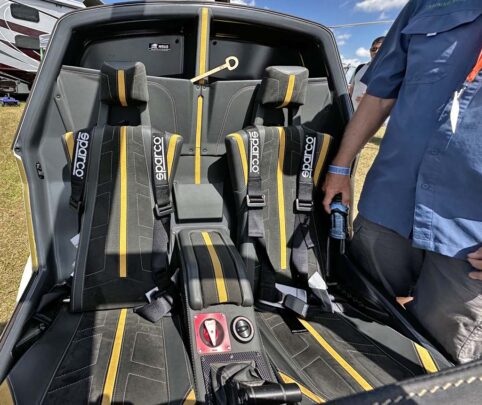All week at Sun and Fun 2023 my eye kept drifting to a rather distinctive gyroplane. We’ve seen side-by-side before (AutoGyro, Magni, and Rotorvox, the latter being closet to Nisus). I liked those for the same reason as most pilots. Generally, we enjoy sitting next to our cabin mate although some prefer the “dual solo” configuration of fore-and-aft tandem seating.

No, it was something much simpler.

American Rich Lanning gave me a tour of the Slovakian Nisus Gyro.
Several years ago, Cadillac redesigned their line of luxury cars with what I’d call a “faceted” look, that is, body panels composed of straight or flat surfaces with angular lines (something like the “facets” that help a cut diamond catch the light). I had car-geek friends that simply hated Cadillac’s look. I liked it. I thought it conveyed a strong, formidable appearance. Like a car’s paint color, such design features are very personal.
Nisus Gyroplane
Nisus leaders Jindrich Zahumensky (CEO and founder) and Ondrej Jancovic (COO and product development) have been head-down for three years said U.S. representative, Rich Lanning. What we saw at Sun ‘n Fun 2023 was one of three in existence. However, based a long list of special design qualities and the installation of a potent engine, I predict we’ll see more Nisus gyros.

I realize that a substantial majority of my readers prefer fixed wing aircraft so I keep a rather close focus on conventional three-axis flying machines. However, I like trikes and gyroplanes, too, and they deserve regular coverage for those enthusiasts.

The empennage is a rare (though not unique) gyroplane design with double rudders to improve low-speed maneuvering at low speed, such as during landings.
Getting the Details Right
At Sun ‘n Fun 2023 and once afterward, I visited with Rich to review all the upgrades Jindrich and Ondrej introduced. Some are minor and simple. Others are novel. All have some merit. Let’s review…

✔️ Nisus’ engine cowl unlatches in three places on each side. Pilots must remove the cowling to check the oil. Why the added step? This careful pair of designers wanted to be sure pilots examine the whole engine before flight, not merely check the oil quantity. The engine cowl is secured by latches, not screws; they have guide pins to help seat each latch properly. It only takes a few minutes. Nonetheless, Rich said they have asked about hinging the cowl panels to make this inspection easier. Their goal was good but removing the cowl seems burdensome.

Red arrow depicts a removable, specially-configured weight used when flying solo from the right seat.
✔️ Nisus provides two gas doors. “I’m not sure why they use two fill points,” wondered Rich, “but you can fill from either side into a single tank.” Nisus comes with a fuel dip stick, which can be used on either side to verify quantity. Many aircraft fuel-fill points use a curved pipe that can cause fuel back splash if you refuel too quickly (airports serving large, thirsty airplanes often pump fuel very fast). With Nisus’ straight down pipes, Rich says he never splashes.
✔️ The seat back moves fore and aft either at top or bottom. This is the principal adjustment for shorter or taller pilots. The seat cushion does not move, however, the rudder pedals are adjustable so Nisus fits different sized pilots easily.

Custom-made luggage precisely fits those spaces aft of the seat. Also note fuel tank dipstick at top center.
✔️ The cabin with its large acrylic canopy is vented in front of pedals aided by a variable speed fan. Two canopy side-mounted inlets assure plenty of cabin airflow. For colder climates, Nisus also has heat.
✔️ A fuel cut-off is easy to reach; some design place this important emergency control in harder-to-reach locations.
✔️ Nisus uses pneumatic control supplied by an on-board air compressor for a rotor brake and for the rotor disk trim system. Hydraulics are used for wheel braking.

✔️ A glove box aft of the throttle quadrant has inside it a zippered lining that when unzipped gives access the control cables and more for inspection… another minor but clever way to check your bird before flight.

Nisus’ canopy swings down but also slides fore and aft to ease entry and exit.
✔️ Less frequently, recommended every 100 hours, you can perform a simple check for weldment fatigue — cracks in the chrome moly welds — by using an access point to pressurize the steel tubes. With the correct technique this could uncover a major problem before it arises.
✔️ Nisus offers custom-designed passenger luggage that perfectly fits openings behind the seats while matching the interior.
✔️ Kanardia avionics are installed.
✔️ Nisus is amply powered by a 141 horsepower Rotax 915iS as standard. Engine inlets for cooling appear top and bottom of the engine compartment with plenums to direct the air.
✔️ Rich noted that Nisus offers a very tight turning radius.
✔️ Pre-configured weights that are custom fit to a location in front of the rudder pedals are provided. This mass is used during solo operation; the pilot-in-command sits in the right seat.
TECHNICAL SPECIFICATIONS
Nisus Gyroplane
all specifications provided by the Slovak factory
- Length — 16.6 feet
- Width — 5.5 feet
- Height — 8.9 feet
- Cabin Width — 51 inches
- Cruise Speed — 70-86 knots
- Maximum Speed — 105 knots
- Engine — Rotax 915iS, fuel injected, intercooled
- Power — 141 Horsepower
- Rotor — Gyrotech (brand) 28.25 feet diameter
- Fuel Tank Capacity — 24 U.S. gallons
- Airframe (primary structure) — Welded chrome molybdenum steel tubes
- Propeller — Composite, 3-blade
- Takeoff Distance — 656 feet
- Landing Distance — 492 feet
- Takeoff Roll — 230-390 feet
- Landing Roll — 0-60 feet
Nisus got their start in 2005 making the Joker Trike. It continues in production alongside the gyroplane.



Do you still offer kits of the Nisus Gyrocopter?
How much would a kit cost? How about shipping to Hartford, Connecticut, USA?
By all means, use links in the aircraft to contact the company.
Just fantastic. Beautiful.
This is a Fantastic Craft, hope you can Produce them Soon Sir(s). And can Sell them at A Reasonable cost. Would love one of these for Sure. How far can one fly on 24gal. of Fuel (distance & time) Beats all that Driving. So what is the Absolute max Sustained Speed at Altitude available in this Craft? I would really like to know. 115knots would be truely nice. 400miles in 3 hrs. At that Speed. 150mph. Would be Ultimate though. Thanks. John B.
Even Joker trike looks promising!
Looks awesome, I’m hooked and have had an intro flight in a gyroplane. Checkbook, economy, age, and wife are against me.
Gyros have come a long way thanks to innovative design and engineering coming from the folks in Europe.
This is yet another fine example of that skill and craftsmanship.
For me it is exciting to see and while my check book says yes my age says no,.:-(
Where was this stuff 20 years ago 🙂
I wish them much success with the aircraft in what is a growing field in light aviation.
Novel idea ! Pressurize the steel tubing for comprehensive early detecting of stress cracks and corrosion. That is a true epiphany ! Congat’s to whoever at Nisus Aero came up with that idea.
Sure is a ‘looker’. I waffle back and forth in tandem and side by side. This does justice to side by side. And with the other clever items it makes a strong case for the side-by-side configuration. What I don’t care about is the need for a more wedge shape to accommodate or offset the width of the side-by-side. As consequence, I prefer elevated tandem. Rising headroom eliminates the
claustrophobia of that tightly wedged glass. But it’s nitpicking. What has always appealed in a Gyro is that twin tail. And besides, what are we doing here? Flying or a trailer queen in the parking lot show?